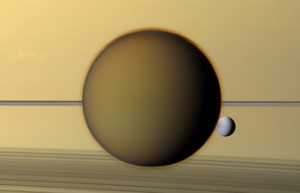Why is it that Saturn’s moon Titan has a dense atmosphere, yet Jupiter’s Ganymede and Callisto (about the same size as Titan) do not?

Blame it on their parent planets. All three moons are a mixture of rocky materials and water ice, and the crystalline structure of ice is particularly good at trapping atoms of gas. But the outward characteristics of these moons are rather different, having been determined by the conditions near each planet as it formed.
For example, the newborn Jupiter was so hot that it probably glowed. This heat drove off all the water within Io and most of it from Europa. Ganymede and Callisto kept their ice, but they still got hot enough to lose most of the gas that might otherwise have been trapped in their icy interiors. Consequently, none of the Galilean moons ended up with a substantial atmosphere.
By contrast, the conditions around Saturn were generally colder. Titan managed to trap considerable gas-rich ice in its interior. Over time, heat from infalling objects and from the decay of radioactive elements within its rocks liberated much of this gas, creating the dense nitrogen-rich atmosphere we see today.
— J. Kelly Beatty
 0
0
Comments
You must be logged in to post a comment.